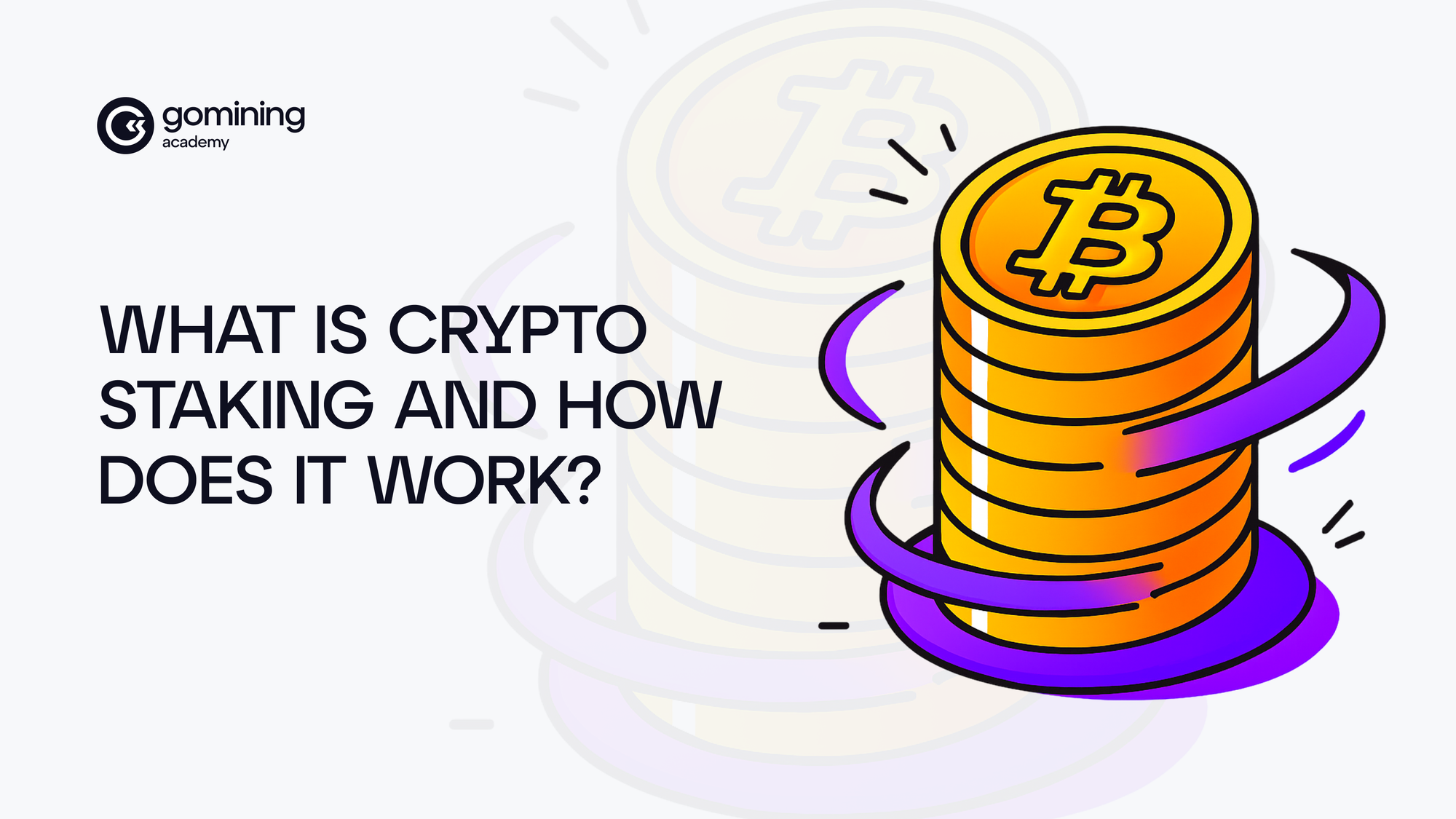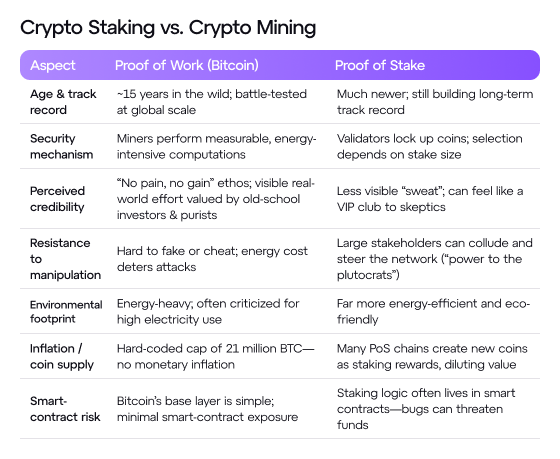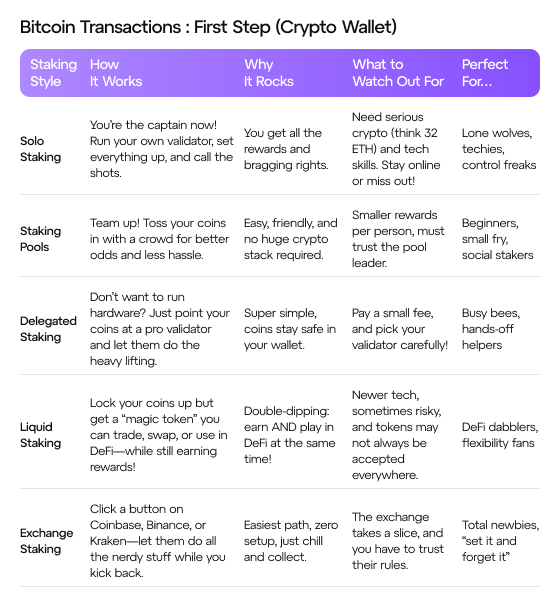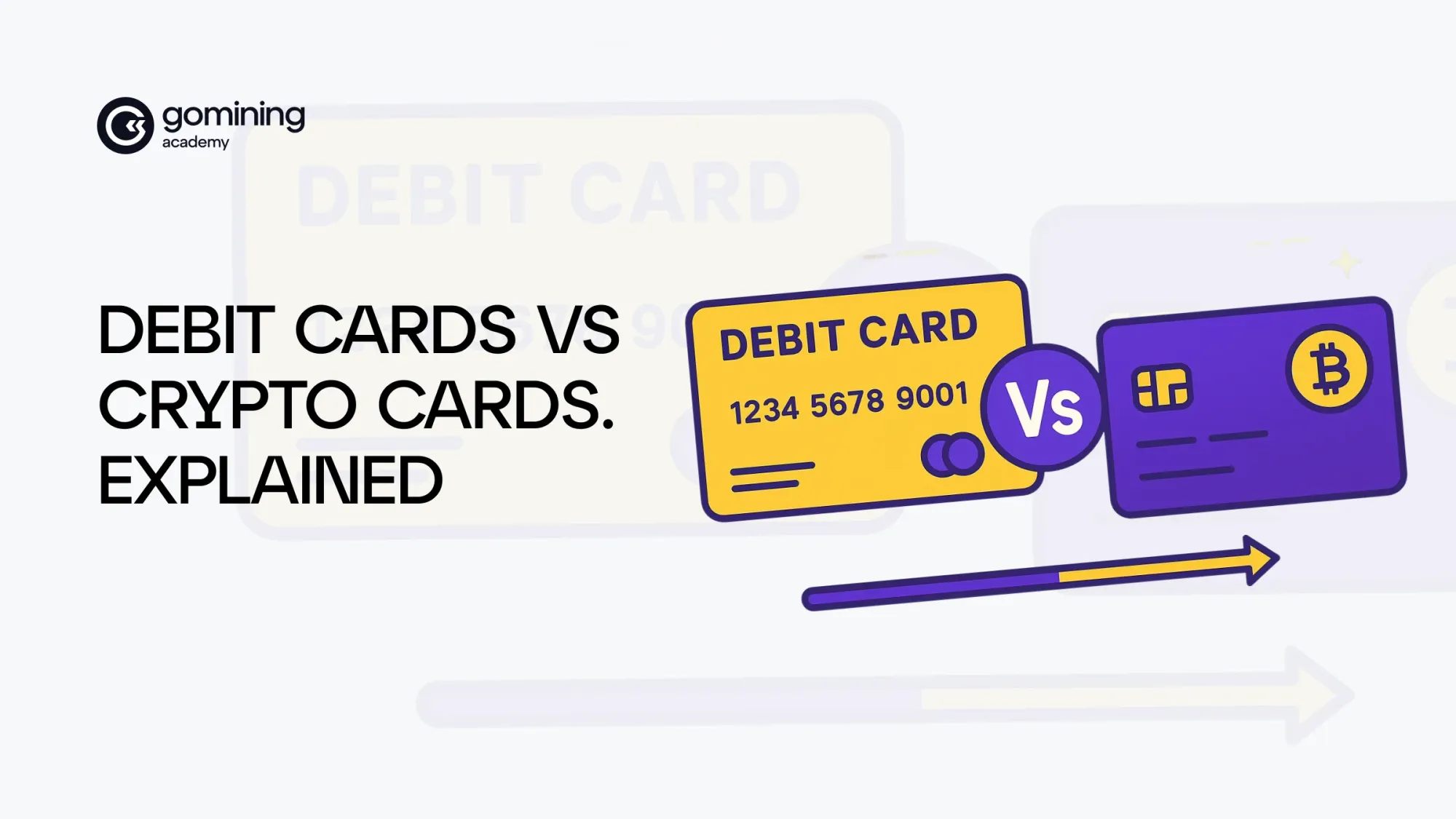What Is Crypto Staking and How Does It Work?

Would you like your cryptocurrency to earn rewards while you relax? That's the core idea of crypto staking.
What is staking crypto, exactly? In simple terms, crypto staking involves locking up your digital coins to help run a blockchain network – in return for more crypto.
Think of it like earning interest in a savings account, however, your rewards come from the blockchain itself—instead of the banks that loan your money out for interest.
We’ll break down what is staking in crypto, how crypto staking works under the hood, and why people do it.
By the end, you’ll know the pros and cons, how to stake crypto step-by-step, and where to do it (with real examples like Ethereum, Cardano, and Solana).
Ready to turn your hodling into earning? Let’s dive in!
Table of Contents:
- How Does Crypto Staking Work?
- Crypto Staking vs. Crypto Mining
- Important Risks: Is Crypto Staking Safe?
- Crypto Staking Calculator
- Things to Consider Before Crypto Staking
- How to Stake Crypto
- Beyond Staking: Passive Income With Digital Mining
- Conclusion
What Does Staking Crypto Mean
Staking plays an important role in how a blockchain works. Blockchains are all about trust—but not in any one person or company. Instead of trusting a bank or a middleman to keep track of everything, you trust the system itself.
The blockchain uses validators – thousands of people all over the world, who help check the rules and agree on what’s real, using math and computer code instead of a single boss. There’s no single authority in charge; it’s a team effort built on transparency and smart algorithms.
When most people think of crypto, though, they picture wild-eyed miners with rooms full of whirring machines battling it out to solve impossible puzzles. That’s Proof-of-Work (PoW)—the original way blockchains like Bitcoin keep themselves safe and honest. PoW is how to mine Bitcoin. In PoW, computers (a.k.a. miners) race to solve tricky math problems. The first one to crack it gets to add the next block to the chain—and snag some sweet crypto rewards.
It’s secure, but it’s also an energy monster. The Cambridge Bitcoin Electricity Consumption Index (CBECI) estimates Bitcoin's annual electricity consumption to be around 193.30 TWh, which is approximately 0.5% of the entire world’s electricity usage. Something like the total amount of electricity Argentina consumes in a year. This leaves some people grumbling about electricity bills and carbon footprints.
How Does Staking Crypto Work
Proof of Stake (PoS) flips the script. Instead of burning electricity, PoS blockchains (like Ethereum 2.0, Solana, or Cardano) pick validators based on the amount of cryptocurrency they have locked up, or 'staked'. These validators review new transactions and help decide which ones make it onto the next block in the blockchain.
Think of validators as referees, checking that everything adds up—no double-spending, no funny business, just honest crypto accounting. Once enough validators agree, the new block is locked in forever and the process starts again.
But why would anybody want to do this? Simple: rewards. When a validator is chosen to help create a new block, the network hands out a prize—usually a mix of freshly minted coins and transaction fees paid by users. The staking process offers validators a chance to earn a passive income.
So, how does the blockchain actually choose who gets to validate a block? It all comes down to how many coins you’re willing to stake. Think of it like becoming a shareholder in the network: the more coins you stake, the larger your “share” and the greater your chances of being selected to validate the next block and earn rewards—much like how shareholders receive dividends based on how many shares they hold.
As mentioned earlier, validators need a minimum amount of coins to qualify—for example, Ethereum currently requires 32 ETH to get in the game. That’s out of reach for most newbies.But don’t worry, you don’t have to be a crypto millionaire to take part in staking in crypto.
Most Proof-of-Stake blockchains let regular folks “delegate” their coins to a professional validator instead. You simply choose a validator, delegate your coins, and combine your “shares” with other users. When your chosen validator is selected, everyone who contributed earns a portion of the rewards based on their share—making it an inclusive, team-based system.
But it’s not all easy money—there’s also a built-in penalty called 'slashing' to keep everyone honest. If a validator tries to cheat, goes offline for too long, or breaks network rules, the network can confiscate (or 'slash') a portion of their staked coins. These penalties can be minor, such as 1-5% for brief downtime, or could involve the validator's entire stake for malicious behavior. This threat affects not only the validator but also anyone who delegated their coins to them, making it a powerful incentive to act reliably.
While Proof of Stake is still considered the “new kid on the block,” it’s quickly growing up. The biggest proof? In 2022, Ethereum—the world’s second-largest blockchain—made headlines with “The Merge,” its epic transition from Proof-of-Work to Proof-of-Stake. This shift not only slashed Ethereum’s energy use by more than 99%, but also showed the world that even the biggest, most established blockchains could embrace crypto staking. The Merge turned PoS from a promising idea into a global, high-stakes reality—and plenty of other projects are following Ethereum’s lead.
Cryptocurrency Staking vs. Crypto Mining
Now that you’ve seen how staking functions—more like becoming a shareholder in the network, where the coins you lock up represent your “stake” and potential for rewards—it’s helpful to compare that model to Bitcoin’s proof-of-work approach.
The table below lines up the two systems on the key dimensions investors care about, from security model and energy use to long-term track record and inflation risk, so you can quickly spot where they converge and where they diverge.

In short, the market still treats Bitcoin’s Proof-of-Work chain as “digital gold”: it trades in the six-figure range and carries a long record of reliability. Proof-of-Stake networks, meanwhile, are expanding quickly and enticing users with efficiency—but they’re still in the phase of proving that they can withstand the same extreme, global pressures that Bitcoin has already survived.
Is Staking Crypto Safe?
Staking can sound like easy money, but in the world of crypto, “risk-free” doesn’t exist. Before your entire crypto assets off to earn their keep, here are the big dangers to watch out for:
- Lock-Up & Illiquidity: Most crypto staking requires locking up your crypto for days, weeks, or even longer. If you need to cash out fast—especially during a wild market swing—you could be stuck waiting.
- Price Volatility: Crypto staking might earn you more coins, but if the price of your crypto takes a dive, your rewards might not make up the difference. Crypto is a rollercoaster—don’t stake more than you’re prepared to ride out.
- Slashing: This is a penalty mechanism that confiscates a portion of a validator's stake if they act maliciously or go offline. While a well-behaved validator has nothing to fear, this is a critical risk when you delegate your crypto. Therefore, you must carefully vet your chosen validator. Look for providers with a long history of high uptime and a positive community reputation to minimize the risk of your delegated funds being slashed.
Crypto Staking Calculator: Crunching the Numbers Before You Stake
Curious how much you could earn from crypto staking? That’s where a crypto staking calculator comes in handy. These simple online tools let you estimate your potential rewards before you lock up your coins. Just plug in the amount you want to stake, the APY, and the staking period—the calculator does the math and shows you how much you might earn in coins or dollars.
Why use one? You’ll get a realistic preview of possible returns, can easily compare different coins, and won’t be surprised by things like validator fees or inflation (if the calculator includes those). Just remember, APYs and rewards change, so think of these results as a helpful guide—not a guarantee. You can find staking calculators online.
Staking Cryptocurrency The Smart Way
Ready to let your coins earn their keep? Here’s your quick checklist to make sure you’re staking crypto the smart way:
- Staking rewards vary: Ethereum pays around 3–5% APY(Annual Percentage Yield), while newer blockchains like Solana, Polkadot, or Avalanche sometimes offer 8–15%. However, there is a catch : higher rates can mean higher risk
- Lock-Up & Unbonding Periods: How long are your coins stuck? Some networks let you unstake anytime; others have cool-down periods. Make sure you won’t need those funds in a hurry.
- Validator Selection: If you’re delegating, research your validator! Look for strong performance, solid uptime, and good community reputation. Picking poorly could mean slashed rewards or lost coins.
- Fees: Exchanges, pools, and validators all take a cut—sometimes more than you expect. Compare net yields after fees, not just the big numbers.
- Taxes: In many places, crypto staking rewards count as taxable income, and selling them can trigger capital gains tax. Keep records and check the rules where you live.
- Other Risks: Review the section above for more details on volatility, slashing, and decentralization.
Bottom line: Staking is a powerful tool, but it pays to read the fine print, do your homework, and know the risks before you lock up your crypto!
Best Crypto For Staking
There is no way to answer this, unless you can peer into the future. Reward rates, network stability and market sentiment can all shift overnight. Instead, treat staking as a risk-adjusted yield game: blue-chip chains such as Ethereum currently pay a modest 3-5 % APY, while newer Proof-of-Stake networks like Solana, Polkadot or Avalanche may flash 8-15 % to attract capital. Higher rates, however, usually signal higher volatility, greater technical risk or a token supply that inflates more aggressively.
How to Stake Crypto
So, you’re ready to jump into crypto staking—but how to stake crypto? Good news: there’s a staking style for everyone, from lone wolves to team players and even those who like a little flexibility.
Let’s break down your options:

Beyond Staking: Passive Income With Digital Mining
Apart from staking crypto, there is the classic way of banking on Bitcoin mining profitability. Bitcoin is increasingly gaining interest not only from big financial institutions such as BlackRock but also from independent states, some of which have already created a strategic Bitcoin reserve.
Conclusion
Let’s be honest—everyone loves earning money while doing nothing. Crypto taking lets your crypto work for you, quietly piling up rewards while you sleep, binge-watch your favorite series, or plot your future crypto empire. Your coins earn more coins, just by being locked up and supporting the network. It’s the ultimate “set it and forget it” income stream.
But crypto staking isn’t just a way to score passive rewards—it’s the backbone of Proof of Stake networks. When you stake your coins, you help keep the blockchain secure, honest, and truly decentralized. The network gets stronger and more trustworthy, and you get to watch your crypto stack quietly grow. It’s a win-win: you earn while supporting the very system that makes staking possible. In the end, staking turns every coin-holder into an active player in the world of crypto, making the whole ecosystem safer, greener, and more rewarding for everyone.


